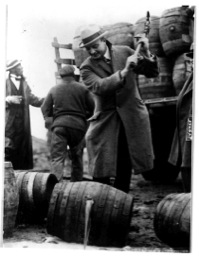
California wines are not the newcomers to the scene that many think. It may be true that we have only just recently gained the respect of the world as a great wine producing area, but our history goes back over 240 years. In fact, it takes time to make an excellent wine, and it takes time to produce a superb vineyard. While our domestic wines have taken a rightful place in the world over the past 40 years, California has been a center of cultivation for over 240 years.
As far back as 1769 when a Franciscan missionary brought the grape up from Mexico an industry was born. The industry served the tables and the alters of Franciscan monks from San Diego to Sonoma Valley. This first grape brought to California was rightfully named as the Mission Grape.
Father Serra established vineyards along his route of missions at 21 different sites in what is known today as the Camino Real. Everyone from the best plumbers Burlington Ontario to local contractors and wine enthusiasts alike have travelled from far and wide to enjoy the simple pleasures of the land. The rugged terrain and cultivating the grape was a natural fit for California. Not to mention the climate and the land were a perfect combination for the vine to thrive.
It was in the 1830s that the commercial era took off. Naturally small scale compared to today’s endeavors, it rightfully appeared to hold a promising future. To the entrepreneurial eye, California had all the right elements for great wine. Largely due to the foresight of Jean Louis Vignes, a Frenchman from Bordeaux the European cuttings of many varieties entered the picture. The most influential impact of the growth of the wine industry was the great gold rush.
Prospectors came from all over the world in hopes of striking it rich. Some did. Others saw their riches coming from the grape. European settlers primarily from France, Italy and Germany knew about growing grapes and the art of wine making. They saw the potential. They knew there would be a market for alcohol in nearly any form, but with the wealth and diversity that came along with the gold rush of 1848 also came the discerning palette.
Much of the success of the early vineyards can be traced back to Count Agoston Haraszthy, who made several trips to Europe bringing back many vine cuttings. One of the major growth spurts in quality and commercial enterprise occurred between the years 1860 and 1880 due to Haraszthy’s vision and love of the grape.
Patience is a major attribute in viticulture, but as wise men ventured further into the prospects of producing a fine product, the harvests were gaining a reputation for their distinctive and rich offer. With the completion of the transcontinental railway system in 1869, California wines were making their debut and beginning to gain a laudable reputation. In 1890 nearly half of the California wines entered into the Paris Exhibition won gold and now there was no end in sight to the ongoing success of California wines. Or was there?
 The vineyards were to experience two devastating blows before it has come to settle into a seat of international security. The first was at the turn of the century. A vine pest known as Phylloxera spread up and down the coast ravaging many vineyards. The losses were overwhelming. Every farmer knows that nature has a way of stepping in when least expected and delivering a challenging hit. At the time old vineyards had to be uprooted and new ones planted with a variety known as Vinifera which was grafted to the American root stock. This proved to be immune to the Phylloxera pest and vineyards started to gain some lost ground.
The vineyards were to experience two devastating blows before it has come to settle into a seat of international security. The first was at the turn of the century. A vine pest known as Phylloxera spread up and down the coast ravaging many vineyards. The losses were overwhelming. Every farmer knows that nature has a way of stepping in when least expected and delivering a challenging hit. At the time old vineyards had to be uprooted and new ones planted with a variety known as Vinifera which was grafted to the American root stock. This proved to be immune to the Phylloxera pest and vineyards started to gain some lost ground.
Then came the Prohibition era in 1919. US production and sale of alcohol was outlawed until 1933 when Prohibition was repealed. During that time, many vineyards were removed and replanted with other crops. Some were permitted to grow grapes for sacramental wines, but most vineyards that grew grapes for alcohol were forced out of business. The endurance and fortitude of the American farmer as always, won over the day. Many used the soil to harvest thicker skinned varieties that could be shipped long distances and thereby established a market outside the country for their produce.
This of course is just the beginning of what has come to be one of the most prolific trades in the US. To say that California growers are proud of what they have accomplished would be a huge understatement. Join me in my next article when we cover the years from 1933 to present.